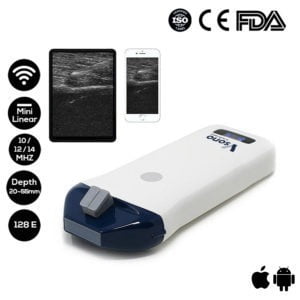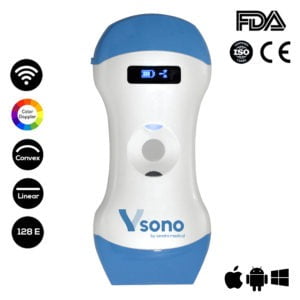Why ultrasonography?
Ultrasound scanners can identify a range of soft-tissue foreign materials, such as wood splinters, glass, metal, and plastic, as well as evaluate the soft-tissue problems that come with them.
Suitable ultrasound scanner:
For ultrasound assessment of soft-tissue foreign bodies, The Wireless Linear Ultrasound Scanner: Vsono-L1 is recommended. The Vsono-L1 is a high-frequency (7.5 MHz and higher) linear-array transducer that is ideal. The ultrasound offers an increased spatial resolution, allowing for high-precision anatomic detail of tiny structures and the detection of foreign bodies (FBs) smaller than 1mm in diameter.
Procedure:
A foreign body was located superficial to the flexor digitorum profundus tendon using ultrasound. And it was readily removed in the emergency department.
Ultrasound scanners can also be used to examine the surrounding muscles, tendons, ligaments, and neurovascular systems, as well as assess any injuries. The most common consequence of a penetrating foreign substance is a soft-tissue infection, with nerve damage a distant second.
Penetrating injuries and the possibility of residual foreign bodies are two of the most prevalent reasons for emergency room visits. Sonography is a valuable tool for detecting and locating radiolucent foreign entities in soft tissue. It can help prevent misdiagnosis during the first emergency examination.
Why ultrasonography?
Ultrasound scanners can identify a range of soft-tissue foreign materials, such as wood splinters, glass, metal, and plastic. As well as evaluate the soft-tissue problems that come with them.
Suitable ultrasound scanners:
For ultrasound assessment of soft-tissue foreign bodies, the Vendra Medical team recommends a high-frequency (7.5 MHz and higher) linear-array transducer, such as The Wireless Linear Ultrasound Scanner: Vsono-L1. The ultrasound offers an increased spatial resolution, allowing for high-precision anatomic detail of tiny structures and the detection of foreign bodies (FBs). smaller than 1mm in diameter.
Procedure:
A foreign body was located superficial to the flexor digitorum profundus tendon using ultrasound, and it was readily removed in the emergency department.
Ultrasound scanners can also be used to examine the surrounding muscles, tendons, ligaments, and neurovascular systems, as well as assess any injuries. The most common consequence of a penetrating foreign substance is a soft-tissue infection, with nerve damage a distant second.



